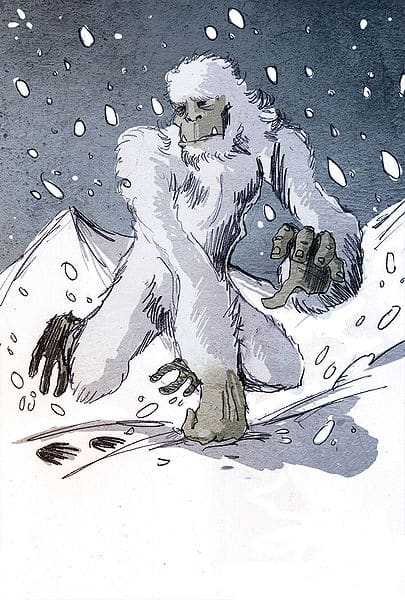Are the Legendary Yeti Actually Ancient Polar Bears?
OutdoorHub Reporters 10.21.13

British geneticist Bryan Sykes recently reported findings that may have a few people raising their eyebrows. Sykes, who is a leading researcher on human ancestry and founder of Oxford Ancestors, says that there may be a connection between the Himalayan Yeti and an ancient Norwegian polar bear. According to NBC News, Sykes made the conclusion after he obtained two samples of what is believed to be Yeti hair and genetically matched them to the 120,000-year-old jawbone of a polar bear found in the Norwegian Arctic.
“All my colleagues think I’m taking a risk in doing this, but I’m curious, and I am in a position to actually do something to answer the questions,” Sykes told NBC.
Finding the truth behind Yetis, Bigfoot, Sasquatch, and other cryptids, or animals whose existence is yet to be proven, is one of the projects Sykes has been working on in addition to more conventional pursuits at Oxford University. The Oxford-Lausanne Collateral Hominid Project (OLCHP) is on the hunt for DNA samples, usually hair, of these elusive creatures for genetic testing. Sykes acknowledges that his research is controversial and may be seen by many as eccentric. That did not stop the geneticist from putting out a call for hair samples in 2012, leading to two promising responses.
“Of the two samples in this study, one came from a Yeti mummy in Ladakh,” Sykes said. “It was from the mummified body that was shot 40 years ago by a local hunter. He kept it because he did not think it was a bear from its behavior. To him it was a Yeti. The other sample was a single hair from the other end of the Himalayas, from the Kingdom of Bhutan. It was found by the king’s own personal Yeti guards.”
The two samples were found nearly 800 miles apart but both were a match to the genetic fingerprint of a polar bear jawbone found in 2004. According to National Geographic, the bone may be up to 120,000 years old. Sykes told reporters that the Yeti may be much different than their ancient ancestors or any modern species of bear, instead belonging to a completely new species or a hybrid of polar bears and brown bears. He believes there because these samples were obtained so recently, there may be “Yetis” still living in the Himalayas.
“I can’t imagine we managed to get samples from the only two ‘snow bears’ in the Himalayas,” he told the Associated Press.
The project’s findings will be aired in a documentary series called the Bigfoot Files, but Sykes intends on finding a live Yeti to confirm his theories. That may take some doing, as no confirmed Yeti has ever been captured or killed. There have been several instances when local hunters thought they had bagged one of the legendary beasts, but none were recognized by the wider scientific community.
The story of the Himalayan Yeti, or Abominable Snowmen, has been around for many years. According to legend, the creature was an ape-like animal larger than the average human and usually covered in white or brown fur.
Aside from starring in local folklore, the Yeti even made it into official government documents when the US Department of State first established diplomatic relations with Nepal. A Foreign Service memo circulating in 1959 established proper protocol on what to do if visitors run into a Yeti. The memo is now generally thought to be a humorous handshake between the US and Nepalese governments, but it highlights the position of the Yeti in popular culture.
Sykes says that he will continue to pursue answers.
“The Yeti, the Bigfoot, is surrounded in myth and hoaxes,” he said. “But you can’t invent a DNA sequence from a hair.”

